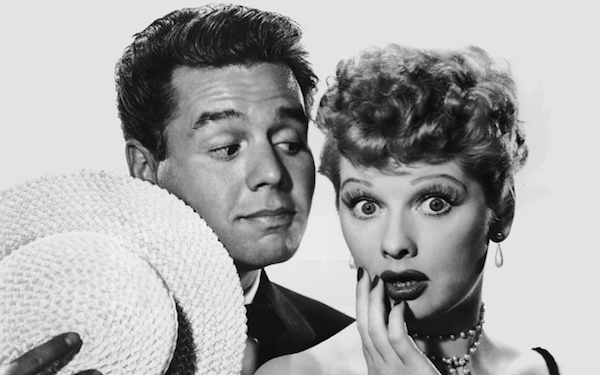Movie review by Greg Carlson
Amy Poehler’s nonfiction feature debut as director is a solid and informative account of the inextricably linked personal and professional lives of two visionary entertainers and broadcasting pioneers. The title “Lucy and Desi” doesn’t require the last names Ball and Arnaz for viewers to instantly identify the powerful pair (or to guess why Poehler would be drawn to the story). They are still household names, decades on. Powered by a massive and well-preserved archive of radio, film, and television material showcasing the hard-working couple separately and together, the documentary – which premiered at the virtual Sundance Film Festival in January before landing on Amazon – is worthwhile viewing for show business aficionados.
Poehler sticks to a straightforward chronological structure, but several key themes emerge along the way. With the participation of Lucy and Desi’s daughter Lucie Arnaz Luckinbill, who presumably provided access to some (if not all) of the home movie footage and audio recordings, the importance of family is rivaled only by discussions of the indefatigable work ethic and business acumen that, combined with a commitment to risk-taking, saw Lucy and Desi forge the empire that would at one time become the biggest independent television production company and studio in Hollywood. “I Love Lucy” was, in part, conceived as a means to get Desi off the road and an opportunity for the pair to spend more time together.
Poehler also reaches out to a select group of individuals for talking head interviews, speaking not only at length with Arnaz Luckinbill, but collecting observations, insights, and anecdotes from Norman Lear, playwright/professor Eduardo Machado, and the children of close Ball/Arnaz creative collaborators. The director’s deliberate concentration on gender issues in the film and television industry, the glass ceiling, and longstanding stereotypes about women in comedy is highlighted by the presence of Carol Burnett, Bette Midler, Laura LaPlaca (Director of Archives and Research, National Comedy Center), and Journey Gunderson (Executive Director, National Comedy Center).
Gunderson imagines the number of times Ball would have encountered sexism via “mansplaining” and patriarchal entitlement. The star’s thanks for assertiveness and interest in the filmmaking process? A lingering and disproportionate focus on “how hard-nosed she could be.” Poehler, no stranger to the same garbage faced by Ball, corroborates Gunderson’s point that Ball maintained an absolute dedication to ongoing improvement in all facets of her career. Ball herself dispels the myth of natural talent and effortless physical comedy in favor of grueling practice and constant rehearsal.
Toward the end of the film, Arnaz Luckinbill notes that the public prefers to imagine Lucy and Desi as a perpetual supercouple, even though their union ended in divorce in 1960 (Arnaz’s infidelities barely merit a mention). Both remarried; Lucy to Gary Morton and Desi to Edith Mack Hirsch. Arnaz Luckinbill points out, “They were married to those people longer than they were married to each other.” Poehler makes certain to strike a steady and careful balance between Ball and Arnaz in the film, allowing them to share the spotlight in a meaningful way far more satisfying than any loose-with-the-facts biopic fictionalization.
